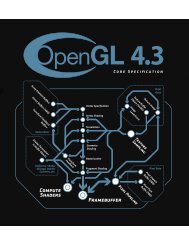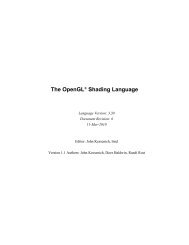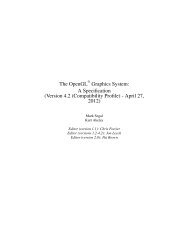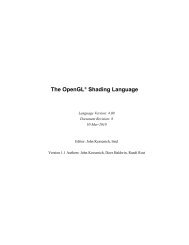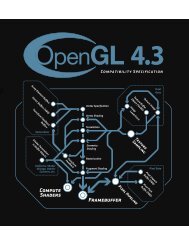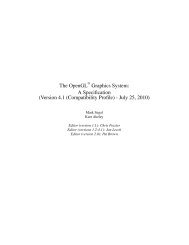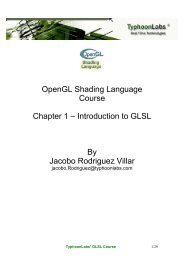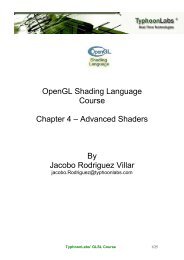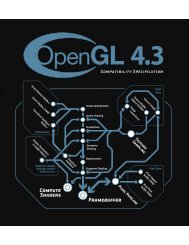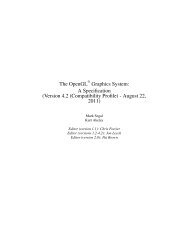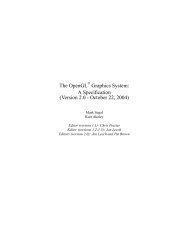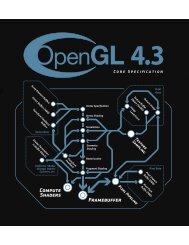OpenGLTM and X, Part 2: Using OpenGL with Xlib
OpenGLTM and X, Part 2: Using OpenGL with Xlib
OpenGLTM and X, Part 2: Using OpenGL with Xlib
Create successful ePaper yourself
Turn your PDF publications into a flip-book with our unique Google optimized e-Paper software.
normal plane window, then create a child window in the<br />
overlay planes <strong>with</strong> the child's origin located at the origin<br />
of the parent. The child should be maintained to have<br />
the same size as the parent. Clear the overlay window to<br />
the transparent pixel value to see through to the parent<br />
normal plane window. Switching between the overlay <strong>and</strong><br />
normal planes windows requires a gl a e urrent call.<br />
It is likely that the overlay visuals will not support the<br />
same frame buer capabilities as the normal plane visuals.<br />
ou should avoid assuming overlay windows will<br />
have frame buer capabilities such as depth buers, stencil<br />
buers, or accumulation buers.<br />
gl se ont routine to create display lists out of X fonts.<br />
either of these methods of font rendering may be exible<br />
enough for a program desiring stroke or scalable fonts<br />
or having sophisticated font needs. In the future, an<br />
<strong>OpenGL</strong> font manager will be available to meet these<br />
needs. In the meantime, you can use gl se ont or X<br />
font rendering or roll your own font support. An easy way<br />
to do this is to convert each glyph of your font into a display<br />
list. Rendering text in the font becomes a matter of<br />
executing the display list corresponding to each glyph in<br />
the string to display.<br />
.<br />
.<br />
In IRIS GL, rendering into an X window using core X<br />
rendering after IRIS GL was bound to the window is undened.<br />
This precluded mixing core X rendering <strong>with</strong> GL<br />
rendering in the same window. <strong>OpenGL</strong> allows its rendering<br />
to be mixed <strong>with</strong> core X rendering into the same<br />
window. ou should be careful doing so since X <strong>and</strong><br />
<strong>OpenGL</strong> rendering requests are logically issued in two distinct<br />
streams. If you want to ensure proper rendering,<br />
you ust synchronize the streams. Calling gl ait will<br />
make sure all <strong>OpenGL</strong> rendering has nished before subsequent<br />
X rendering takes place. Calling gl ait will<br />
make sure all core X rendering has nished before subsequent<br />
<strong>OpenGL</strong> rendering takes place. These requests do<br />
not require a protocol round trip to the X server.<br />
The core <strong>OpenGL</strong> API also includes gl inis <strong>and</strong><br />
gl lus comm<strong>and</strong>s useful for rendering synchronization.<br />
gl inis ensures all rendering has appeared on the screen<br />
when the routine returns (similar to ync). gl lus only<br />
ensures the queued comm<strong>and</strong>s will eventually be executed<br />
(similar to lus ).<br />
Realize that mixing <strong>OpenGL</strong> <strong>and</strong> X is not normally necessary.<br />
Many <strong>OpenGL</strong> programs will use a toolkit like<br />
Motif for their 2D user interface component <strong>and</strong> use a distinct<br />
X window for <strong>OpenGL</strong> rendering. This requires no<br />
synchronization since <strong>OpenGL</strong> <strong>and</strong> core X rendering go to<br />
distinct X windows. Only when <strong>OpenGL</strong> <strong>and</strong> core X rendering<br />
are directed at the same window is synchronization<br />
of rendering necessary.<br />
Also <strong>OpenGL</strong> can be used for extremely fast 2D as well<br />
as 3D. When you feel a need to mix core X <strong>and</strong> <strong>OpenGL</strong><br />
rendering into the same window, consider rendering what<br />
you would do in core X using <strong>OpenGL</strong>. ot only do you<br />
avoid the synchronization overhead, but you can potentially<br />
achieve faster 2D using direct rendered <strong>OpenGL</strong><br />
compared to core X rendering.<br />
<strong>OpenGL</strong> supports immediate mode rendering where comm<strong>and</strong>s<br />
can be generated on the y <strong>and</strong> sent directly to the<br />
screen. Programmers should be aware that their <strong>OpenGL</strong><br />
programs might be run indirectly. In this case, immediate<br />
mode rendering could require a great deal of overhead for<br />
transport to the X server <strong>and</strong> possibly across a network.<br />
For this reason, <strong>OpenGL</strong> programmers should try to use<br />
display lists when possible to batch rendering comm<strong>and</strong>s.<br />
Since the display lists are stored in the server, executing a<br />
display list has minimal overhead compared to executing<br />
the same comm<strong>and</strong>s in the display list immediately.<br />
Display lists are likely to have other advantages since<br />
<strong>OpenGL</strong> implementations are allowed to compile them for<br />
maximum performance. Be aware you can mix display<br />
lists <strong>and</strong> immediate mode rendering to achieve the best<br />
mix of performance <strong>and</strong> rendering exibility.<br />
onclusion<br />
The glxdino example demonstrates the basic tasks that<br />
must be done to use <strong>OpenGL</strong> <strong>with</strong> X. The program<br />
demonstrates sophisticated <strong>OpenGL</strong> features such as double<br />
buering, lighting, shading, back-face culling, display<br />
list modeling, <strong>and</strong> polygon tessellation. And the proper<br />
X conventions are followed to ensure glxdino works well<br />
<strong>with</strong> other X programs.<br />
The glxdino example program <strong>and</strong> the hints for advanced<br />
<strong>OpenGL</strong> programming should provide a good foundation<br />
for underst<strong>and</strong>ing <strong>and</strong> programming <strong>OpenGL</strong> <strong>with</strong><br />
<strong>Xlib</strong>. The next article will explain how to integrate<br />
<strong>OpenGL</strong> <strong>with</strong> the Motif toolkit.<br />
.<br />
Graphics programs often need to display text. ou can<br />
use X font rendering routines or you can use the GLX<br />
11



